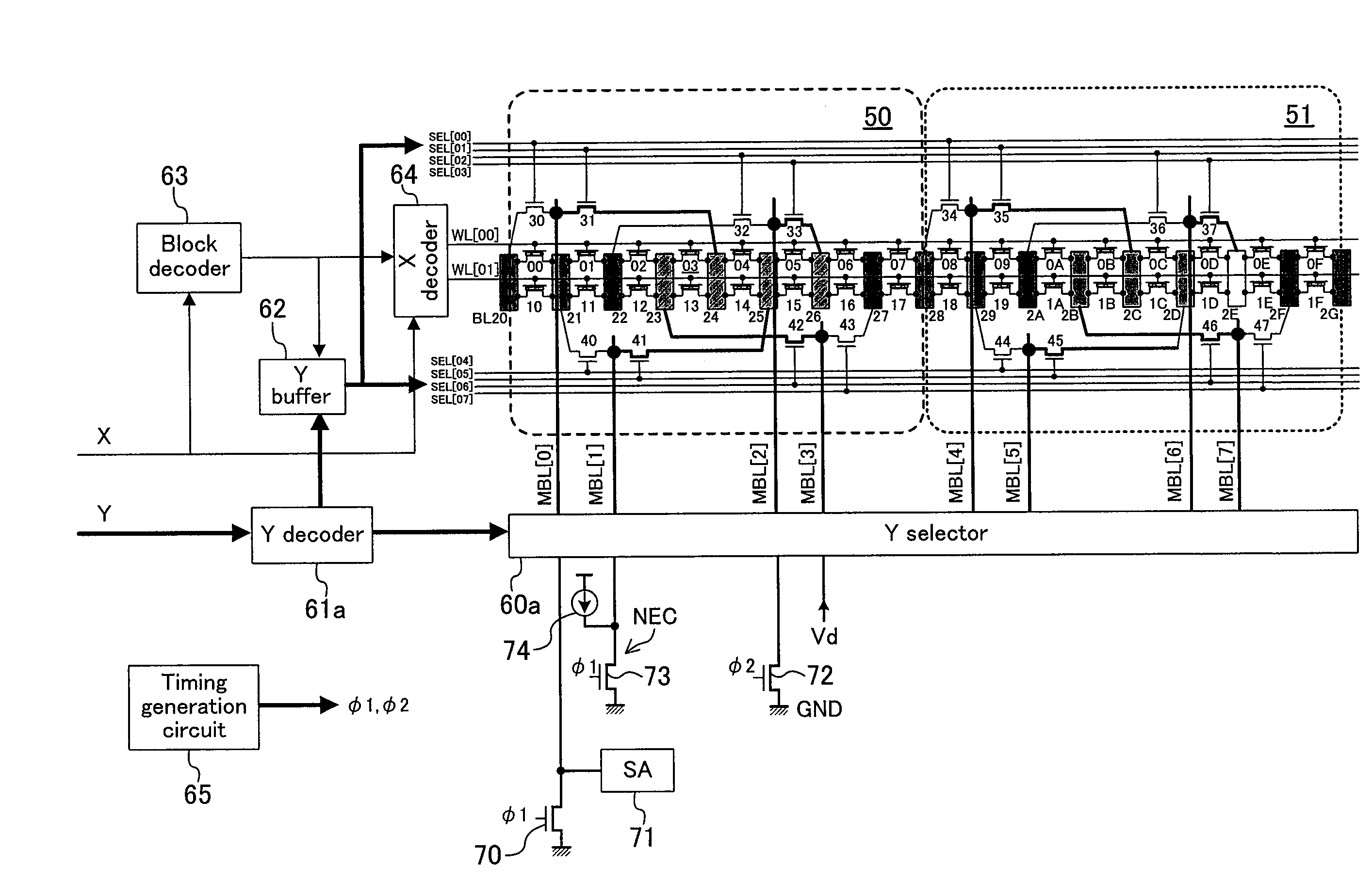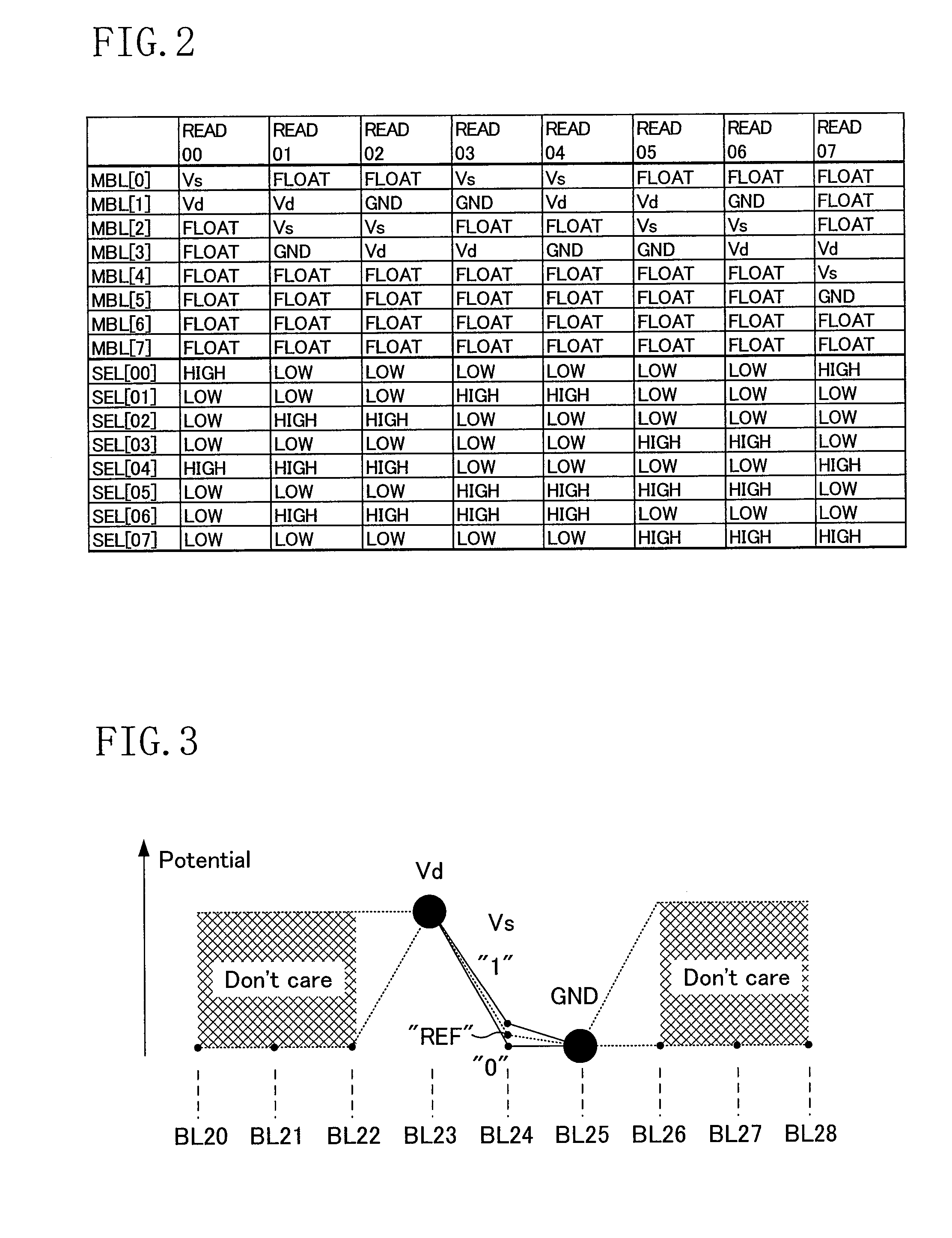Semiconductor non-volatile memory
- Summary
- Abstract
- Description
- Claims
- Application Information
AI Technical Summary
Benefits of technology
Problems solved by technology
Method used
Image
Examples
first embodiment
[0046]FIG. 1 shows a configuration of a semiconductor non-volatile memory according to a first embodiment of the present invention. The semiconductor non-volatile memory of FIG. 1 is a VGA (Virtual Ground Architecture)-type semiconductor non-volatile memory, including an uninterrupted arrangement of memory cells between bit lines, wherein adjacent memory cells share a bit line therebetween. Reference numerals 00 to 0F and 10 to 1F denote memory cells, reference numerals BL20 to BL2G denote bit lines, which together form a memory cell array. For example, the bit line BL24 is connected to both the source of the memory cell 03 and the drain of the memory cell 04.
[0047]In FIG. 1, reference numerals WL[00] to WL[01] denote word lines, reference numerals MBL[0] to MBL[7] denote main bit lines, and reference numerals 30 to 37 and 40 to 47 denote selection gates selectively connecting the bit line BL20 to BL2G to the main bit lines MBL[0] to MBL[7] based on the selection gate signals SEL[00...
second embodiment
[0064]FIG. 4 shows a configuration of a semiconductor non-volatile memory according to a second embodiment of the present invention. In FIG. 4, like elements to those of FIG. 1 are denoted by like reference numerals and will not be further described below.
[0065]In addition to the configuration of FIG. 1, the semiconductor non-volatile memory of FIG. 4 includes the neighbor effect canceller section NEC as a circuit element used during a sensing operation. The neighbor effect canceller section NEC includes the neighbor bit line reset transistor 73, and the current source 74 for supplying a smaller current than the memory-cell-ON current. The current of the current source 74 is adjusted to about the same as the reference current, i.e., about one half of the current when the memory cell is “1”. The neighbor bit line reset transistor 73 receives the same control signal f 1 as that of the sense input reset transistor 70. A Y selector 60a is configured so that the main bit lines MBL[0] to ...
third embodiment
[0080]The configuration of a semiconductor non-volatile memory according to a third embodiment of the present invention is similar to that shown in FIG. 1. In the present embodiment, when reading a memory cell, a bit line that is adjacent to the drain bit line and on the opposite side of the drain bit line to the source bit line is also forcibly set to the ground potential. For example, when reading the memory cell 03, a bit line BL22 that is connected to the drain of the memory cell 02 as the third memory cell whose source is connected to the drain bit line BL23 is also connected to the ground power supply GND. Otherwise, the operation is similar to that of the first embodiment.
[0081]FIG. 7 shows potentials of bit lines in the vicinity of the memory cell 03 being read of the present embodiment, upon completion of the sense integration period. As shown in FIG. 7, the bit line BL22 adjacent to the drain bit line BL23 and on the opposite side of the drain bit line BL23 to the source b...
PUM
 Login to View More
Login to View More Abstract
Description
Claims
Application Information
 Login to View More
Login to View More - R&D
- Intellectual Property
- Life Sciences
- Materials
- Tech Scout
- Unparalleled Data Quality
- Higher Quality Content
- 60% Fewer Hallucinations
Browse by: Latest US Patents, China's latest patents, Technical Efficacy Thesaurus, Application Domain, Technology Topic, Popular Technical Reports.
© 2025 PatSnap. All rights reserved.Legal|Privacy policy|Modern Slavery Act Transparency Statement|Sitemap|About US| Contact US: help@patsnap.com



